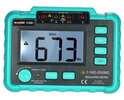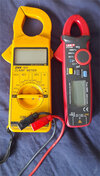Odd that such a set up still exists 6 decades later.
Seen it recently on a rewire.
More lights but all in a central JB - made fault finding easier once I’d located the jb
Odd that such a set up still exists 6 decades later.
This is exactly how it should be.The RCD on the master switch where the supply enters the house tripped, completely out of the blue, with no work or alteration’s having taken place.
I have traced the fault to the ground floor lighting circuit, specifically the feed from the consumer unit to the lights. My multimeter registers continuity across negative and earth on the wires exiting the consumer unit at a junction box immediately after the consumer unit, but only when there is a supply from the master switch. If the master switch is off, there is no continuity...
Why would that be odd? Very common in 1960s homes
Odd that such a set up still exists 6 decades later.

 use DC to detect earth leakage, I paid £35 for one shown, not a 100% as it used DC not AC, but normally works, the other tester does use AC, the original one I had
use DC to detect earth leakage, I paid £35 for one shown, not a 100% as it used DC not AC, but normally works, the other tester does use AC, the original one I had  to the left would measure down to 0.01 amp AC only (10 mA) my new one to right goes down to 0.001 amp (1 mA) cost £35 and this one can show how much is leaking.
to the left would measure down to 0.01 amp AC only (10 mA) my new one to right goes down to 0.001 amp (1 mA) cost £35 and this one can show how much is leaking.
To determine which exhibits the fault, is the best way to isolate each of the four in turn and see which one causes the trip?If you are convinced there exists a fault on that circuit, that JB - best thing to do, is disconnect all of those wires and test each twin and earth separately, to determine which of the four exhibits the fault. No need for any notes as to what goes where - all the reds together, all the blacks, all the earths.
The usual warning applies - of turning the power off, before touching it.

To clarify, I could use an earth resistance tester with the supply off to test each of the circuits from the jb and it measures in ohmsTwo points come to mind, one to test with power off we use either 250 volt or 500 volt, these testers View attachment 320549use DC to detect earth leakage, I paid £35 for one shown, not a 100% as it used DC not AC, but normally works, the other tester does use AC, the original one I had View attachment 320550to the left would measure down to 0.01 amp AC only (10 mA) my new one to right goes down to 0.001 amp (1 mA) cost £35 and this one can show how much is leaking.
There will always be some leakage, due to capacitive and inductive linking, so 9 mA is considered max for each 30 mA RCD, so showing either 10 or 20 mA was not that helpful, really need the one to right to work out how close to the limit.
Both have a ohm range, but at around 8 volt rather useless. However also need to know how to use them, I have clamped the meter around the DNO tails and know overall my house has a leakage of around 26 mA, but that is spread over 14 RCBO's I have never bothered to remove the CU cover to test individual circuits.
The problem is the supply will have the earth linked to neutral somewhere, so to test earth to neutral the isolator must be off, and although some RCBO's are double pole, most are not, and MCB's are hardly ever double pole, caravans are an exception to the rule, so in the main to test means the circuit needs disconnecting.
With the clamp on you only want line and neutral through the clamp, so only place is inside the CU, and you have to test with power switched on. So there is some danger, the same using the insulation tester with 250 volt, so I am not happy telling any non electrician to start poking around inside a live CU.
To clarify, I could use an earth resistance tester with the supply off to test each of the circuits from the jb and it measures in ohms
And a clamp meter is used with the supply on and it measures in miliamps

Just wondering, a while ago, an outbuilding tripped the RCD in the consumer unit (not the main supply one that is tripping now).Try it for continuity/ shorted, with the meter you have - it might just identify the fault which trips the RCD, assuming that is where the fault is - but I have my doubts, that is where the problem lies.
Forget anything more than your cheap meter, the items mentioned by Eric, are expensive, and intended for the pros to use.

This is in some way true, there is a point where one needs to say "I need an electrician" the problem is beyond my skill set.Forget anything more than your cheap meter, the items mentioned by Eric, are expensive, and intended for the pros to use.
Just wondering, a while ago, an outbuilding tripped the RCD in the consumer unit (not the main supply one that is tripping now).
Is it possible for a fault on the outbuilding circuit to cause an issue with the lighting circuit, even if the outbuilding is switched off at the consumer unit?
And a clear picture of this one as well.The RCD on the master switch where the supply enters the house tripped,

Maybe a photo of the main cu would help, showing the incoming RCD
Maybe a photo of the main cu would help, showing the incoming RCD

And a clear picture of this one as well.

If you need to find a tradesperson to get your job done, please try our local search below, or if you are doing it yourself you can find suppliers local to you.
Select the supplier or trade you require, enter your location to begin your search.
Are you a trade or supplier? You can create your listing free at DIYnot Local
